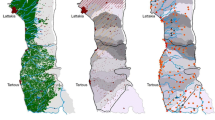Abstract
Before 1960, the Aral Sea was the fourth-largest body of water on Earth. Today, it is on the edge of extinction. The Sea is fed by Central Asia’s two major rivers, the Amu Darya and the Syr Darya, with a flow, respectively, of about 70 and 35 cubic kilometers per year on average. Today, the Aral story is quite well known to environmental groups within and outside the region. The Amu Darya’s watercourse serves as an international border between Tajikistan and Afghanistan and between Uzbekistan and Afghanistan. The Amu Darya crisscrosses Turkmenistan and, for the most part, traverses the length of Uzbekistan and its subregion known as Karakalpakstan. Although an upstream riparian country, Afghanistan has been at war for a couple of decades and in-country conflict remains. As a result, it has had little opportunity to lay claim to its legitimate share of Amu Darya water. With an end to the Russo-Afghan war, an end to the Taliban regime, and with international involvement to bring a semblance of peace and stability to the country in the conflict-laden post-Taliban period, the new Afghan government will surely lay claim to a significant share of Amu Darya water as it reconstructs the nation’s agricultural sector. This paper discusses issues related to the problems and prospects for sustainable development in the Amu Darya basin.
Similar content being viewed by others
References
Amin, T.: 1994, ‘Pakistan, Afghanistan and the Central Asian states’, in A. Banuazizi and M. Weiner (eds.), The New Geopolitics of Central Asia and its Borderlands, Bloomington, Indiana, Indiana University Press, pp. 216–231.
Barlow, M. and H. Cullen: 2002, The Climate Perspective of Greater Central Asia, Unpublished manuscript prepared for meeting. Available from authors at hcullen@ucar.edu.
BBC News: 2002, Central Asia Gas Deal Signed, 30 June 2002.
Boulding, K.: 1971, Collected Papers, Vol. II, Foreword to T.R. Malthus, Population, The First Essay. Boulder, CO, Colorado Associated University Press, pp. 137–142.
Bruntland, G. (ed.): 1987, Our Common Future: The World Commission on Environment and Development, Oxford, Oxford University Press.
CNN.com: 2000, Uzbeks ask for Drought Aid, see 1 Million at Risk, September 21, 2000.
Ellis, W.S.: 1990, ‘A Soviet sea lies dying’, National Geographic Magazine 117(2), 73–93.
Glantz, M.H. (ed.): 1999, Creeping Environmental Problems and Sustainable Development in the Aral Sea Basin, Cambridge, UK, Cambridge University Press.
Glantz, M.H.: 2002, Water, Climate, and Development Issues in the Amu Darya Basin, Proceedings of Workshop held June 2002 in Philadelphia, Pennsylvania. Available from Boulder, Colorado: Environmental & Societal Impacts Group, National Center for Atmospheric Research.
Glantz, M.H., Ye, Q. and Ge, Q.: 2001, ‘China’s western region development strategy and the ur-gent need to address creeping environmental problems’, Arid Lands Newsletter (Online), 49, http://ag.arizona.edu/OALS/ALN/aln49/glantz.html
Hoffer, E.: 1976, The Ordeal of Change, New York, Buccaneer Books.
Horsman, S.: 2001, ‘Water in Central Asia: Regional cooperation or conflict?’, in R. Allison and L. Jonson (eds.), Central Asian Security: The New International Context, Washington/London, Brookings Institute/RIIA.
Insarova, K.: 2002, ‘Parched Uzbekistan covets Russian river waters’, Environmental News Service 30 April 2002: www.gci.ch/DigitalForum/digiforum/articles/article2002/parcheduzbekistan.html
IPCC: 1998, The Regional Impacts of Climate Change: An Assessment of Vulnerability, A Special Report of IPCC Working Group II. Cambridge, UK, Cambridge University Press, pp. 233–234, 257.
IPCC (Intergovernmental Panel on Climate Change): 2001, Climate Change 2001: The Scientific Basis, Contribution of Working Group II to the Third Assessment Report. Cambridge, UK, Cambridge University Press.
Kovda, V.A.: 1980: Land Aridization and Drought Control, Westview Special Study in Natural Resources and Energy Management, Boulder, CO, Westview Press.
Moldogaziev, A.: 2002, Water and Energy Issues in Central Asia, The Central Asia and Caucasus Institute at Johns Hopkins University (mimeo).
Rasmussen, J.A.: 1997, ‘Perspectives on Petroleum Profitability’ at www.eia.doe.gov/emeu/perfpro/pi&t97/text_box.html
Renger, J.: 1998, ‘The institutional framework of water management in the Aral Sea Basin and Uzbekistan’, European Union – TACIS Programme.
Romanova, O.: 2001, ‘Uzbek drought,’ Institute for War and Peace Reporting, Issue No. 66, August 22.
Vinogradov, S. and Langford, V.P.E.: 2001, ‘Managing transboundary water resources in the Aral Sea Basin: In search of a solution’, Int. J. Global Environmental Issues 1, 3–4.
Watson, R.T., Zinyowera, M.C. and Moss, R.H. (eds.): 1998, ‘An assessment of vulnerability’, Sum-mary for Policymakers: The Regional Impacts of Climate Change, A special report of IPCC Working Group II, published for the Intergovernmental Panel on Climate Change. Cambridge, UK, Cambridge University Press.
Wegerich, K.: 2002a, ‘Natural drought or human-made water scarcity in Uzbekistan?’, Central Asia and the Caucasus 2(14).
Wegerich, K.: 2002b, Coping with the Disintegration of a River-Basin Water Resource Man-agement System: Multi-Dimensional Issues in Central Asia, Copies available from author at wegerich@yahoo.com
Wilhite, D.A. and Glantz, M.H.: 1985, ‘Understanding the drought phenomenon: The role of definitions’, Water International 10, 111–120.
Wilson, M.: 2002, ‘Turkmenistan: New prestige water project may harm the environment’, IRIN News, www.dogryyol.com/eng/article/383.html
Zonn, I.S.: 2002, Water Resources of Northern Afghanistan and their Future Use, Unpublished paper prepared for meeting. Available from ESIG at jan@ucar.edu
Zonn, I.S., Nihoul, J.C.J., Kosarev, A.N. and Kostianoy, A.G. (eds.): 2002, A Bibliography on the Aral Sea, Moscow, Noosphere. 231 pp.
Author information
Authors and Affiliations
Additional information
The National Center for Atmospheric Research is sponsored by the National Science Foundation and managed by the University Corporation for Atmospheric Research.
Rights and permissions
About this article
Cite this article
Glantz, M.H. Water, Climate, and Development Issues in the Amu Darya Basin. Mitig Adapt Strat Glob Change 10, 23–50 (2005). https://doi.org/10.1007/s11027-005-7829-8
Received:
Accepted:
Issue Date:
DOI: https://doi.org/10.1007/s11027-005-7829-8




